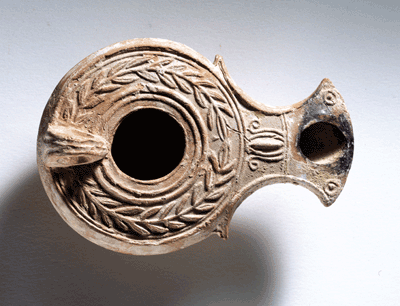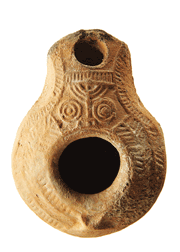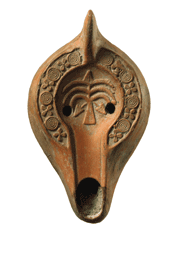THE JEWISH WORLD
Let There Be Light
Over the ages,
oil lamps have vividly reflected the customs and aspirations of diverse
societies dwelling in the Land of Israel.
In the modern world,
there is not a great deal of difference between day and night; darkness
is merely a temporary nuisance, easily vanquished by touching a switch.
In ancient times, however, darkness was not as easily overcome.
Accordingly, the oil lamp was one of the most important household
appliances in antiquity. For over three millennia, it lit the homes,
temples, synagogues, and churches of the Holy Land.
According to Jewish
tradition, it is one of the items that a husband is obliged to provide
for his wife (Tosefta, Ketubot 5:8). An individual who lacked a lamp was
in desperate straits: To be “in want of all things” meant “in want of
lamp, of knife, and of table” (Avot de-Rabbi Nathan, version A, ch. 20).
The oil lamp’s light
was a symbol of life, in both ancient and modern times. “The human soul
is the lamp of the Lord,” says a biblical proverb (Prov. 20:27). “Lord,
You are my lamp, my God lights up my darkness,” David declares (2 Sam.
22:29).
An exhibition of oil
lamps used in the Land of Israel from the Bronze Age to the late Islamic
period held at the Bible Lands Museum Jerusalem last Hanukka gave the
public a greater understanding of these vessels and illuminated various
aspects of life in the
Holy Land. The
exhibition will be on display at the
Museum of Biblical Art in New York
until February 26, 2006.

Evolution of the Oil Lamp
The first known
lamps from the Middle Bronze Age (2300-1800 BCE) are simple wheel-made
bowls, with four slight pinches (tongues) at the top to hold four wicks.
Lamps from the later Middle and Late Bronze Ages (2000-1200 BCE) and
Iron Age (1200-560 BCE) have only one pinch for the wick. Only minor
changes were introduced during the Canaanite and Israelite periods.
In the Hellenistic
period (333-168 BCE), the Greeks introduced the closed oil lamp, which
was distinguished by its two separate compartments: the oil reservoir,
constituting the major part of the lamp, and the chamber into which the
wick was inserted. The Hasmonean Jews’ repudiation of all things
Hellenistic included the rejection of the closed Hellenistic lamp. As a
result, the “Hasmonean lamp” is based on the earlier open lamp, but the
fold that forms the mouth is so pronounced that the two sides of the
mouth come together. This lamp gives concrete expression to the Jewish
opposition to Greek influence in private life as well as in the Temple.
This period also
marks the beginning of the manufacture of mold-made decorated lamps in
the Land of Israel. Mold-made lamps gradually replaced wheel-made bowl
lamps. The simple but elegant Herodian lamps (37 BCE-70 CE) are the
first type found mainly in Jewish settlements and are therefore thought
to have been used primarily by Jews in the late Second Temple period.
Another style, known as “Darom,” refers to the type of lamp found in
caves in the Judean Desert and the lowlands, a region called Darom in
the Mishna and other sources; such lamps have been dated to the period
between the Jewish war against the Romans and the Bar Kochba Revolt (ca.
70-150 CE).
Other inhabitants of
the Land of Israel used a variety of lamps. While the Nabatean lamps
have mostly geometric decoration, the highly decorated Roman imperial
lamps (100-300 CE) were quite prevalent. Roman oil-lamp manufacturers
used molds as a method of mass production, lowering the price while
still leaving plenty of free space on the surface of the lamp for
ornamentation. Their popularity and abundance led not only to the
widespread export of the lamps, but also inspired provincial
manufacturers to establish their own local workshops, copying the Roman
prototypes.
Samaritan-type oil
lamps of the fourth through seventh centuries have been found in large
numbers in Samaria-Sebaste and other areas where Samaritan communities
were concentrated. They were sold with a sealed filling-hole (which was
broken by the purchaser), possibly to ensure ritual purity.
Local Byzantine
lamps, many with Christian symbols, began to appear in the fifth
century. The most recent lamps displayed at the Bible Lands Museum were
Islamic lamps from the eighth through thirteenth centuries.
The Hanukka Lights

The kindling of
lights on Hanukka is associated with the miracle of the jar of oil used
to light the Temple menorah, which was
composed of oil lamps. The menorah of the Tabernacle depicted in the
Book of Exodus (25:31-40; 37:17-24) consisted of a central shaft
from which three branches issued on either side, at three junctions
called kaftorim (“calyxes”). Each branch ended in a perah (“flower”),
in which an oil lamp rested. These, then, were separate lamps, and not a
single lamp with multiple mouths; they also were distinct from the body
of the menorah itself, and apparently were made of gold, as was the body
of the menorah.
ERETZ thanks Dr. Joan Westenholz and Riki Morginstin of the Bible Lands
Museum for their assistance with this article. |


